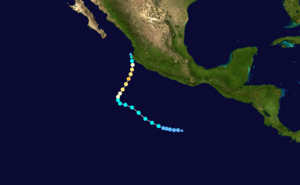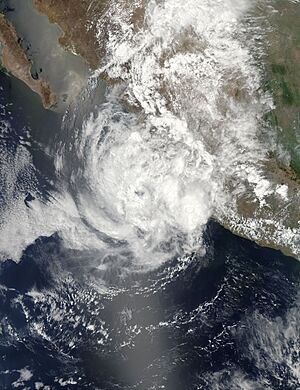Hurricane Bud (2012) facts for kids

Bud near peak intensity on May 24
|
|
| Meteorological history | |
|---|---|
| Formed | May 20, 2012 |
| Dissipated | May 26, 2012 |
| Category 3 tropical cyclone | |
| 1-minute sustained (SSHWS/NWS) | |
| Highest winds | 115 mph (185 km/h) |
| Lowest pressure | 961 mbar (hPa); 28.38 inHg |
| Overall effects | |
| Fatalities | None |
| Damage | Minimal |
| Areas affected | Western Mexico |
|
Part of the 2012 Pacific hurricane season |
|
Hurricane Bud was a powerful storm that formed in May 2012. It was a rare type of storm for that time of year. Bud became a major hurricane and moved close to the western coast of Mexico.
It was the second tropical cyclone and named storm of the 2012 Pacific hurricane season. Bud started as a low-pressure area south of Mexico on May 20, 2012. It slowly grew stronger, becoming Tropical Storm Bud the next day.
On May 24, Bud quickly became a hurricane. It reached its strongest point on May 25, as a Category 3 hurricane with winds of about 115 miles per hour (185 km/h). Soon after, it began to weaken quickly as it moved closer to Western Mexico. Bud completely disappeared the next day.
Because Hurricane Bud weakened before reaching land, its effects were not very severe. However, it still brought heavy rain and large waves to some areas. No one died because of Hurricane Bud.
Contents
How Hurricane Bud Formed and Grew
Hurricane Bud began as a tropical wave that left the coast of West Africa on May 5, 2012. This wave slowly gained strength as it moved west. It caused thunderstorms and rain showers in the Windward Islands.
By May 12, a low-pressure system formed from this tropical wave. It was located just south of eastern Panama. The conditions were good for it to grow. The National Hurricane Center started watching this system closely.
On May 20, the system began to organize quickly. It was moving slowly toward the west-northwest. Later that day, experts believed it would soon become a tropical depression. Tropical Depression Two-E officially formed at 6:00 PM UTC on May 20. It was about 525 miles (845 km) south of Acapulco, Guerrero, Mexico. Even with some wind shear, experts thought it would quickly become a hurricane.
Bud Becomes a Tropical Storm
As the depression moved west, it continued to get stronger. On May 22, it became Tropical Storm Bud. Its winds were about 40 miles per hour (65 km/h). Bud stayed at this strength for a day.
It started to strengthen again on May 23. By the afternoon, its winds reached about 65 miles per hour (105 km/h).
Bud Becomes a Major Hurricane
On the morning of May 24, Bud began to get much stronger very quickly. Its winds reached about 85 miles per hour (137 km/h). By the afternoon, they were about 110 miles per hour (177 km/h). The storm then turned northward.
Later on May 24, Bud turned northeast and moved closer to the coast of Western Mexico. Late that day, Bud became a Category 3 Major Hurricane. It reached its strongest point with winds of 115 miles per hour (185 km/h). Its lowest central pressure was 960 millibars.
Hurricane Bud stayed a Category 3 storm for several hours. Its outer rainbands, which are bands of rain and wind, even started to move onto the coast of Western Mexico. Very early on May 25, Hurricane Bud weakened to a strong Category 2 hurricane.
Bud Weakens and Disappears
Hurricane Bud quickly lost its strength as it moved slowly toward land. It lost most of its thunderstorms and heavy rain. By the middle of the afternoon on May 25, Bud weakened to a strong tropical storm. It began to make landfall in Western Mexico.
It continued to weaken over the next 24 hours. Early on May 26, Bud became a remnant low, which is just what's left of a storm. By late on May 26, the remains of Hurricane Bud completely disappeared.
How People Prepared and What Happened
By early on May 24, the Government of Mexico issued a tropical storm watch. This meant a tropical storm was possible for areas from Punta San Telmo to La Fortuna. Later that day, the watch became a warning, meaning a tropical storm was expected. It was also extended to Cabo Corrientes. A hurricane watch was also issued for the same area.
By 9:00 PM UTC on May 24, the warnings between Cabo Corrientes and Manzanillo were upgraded to a hurricane warning. Another tropical storm watch was issued northward to San Blas.
To prepare for possible evacuations, 11 schools in Colima and Jalisco were closed. The port of Manzanillo was closed because of the threat of heavy rains. Officials in Puerto Vallarta temporarily stopped people from swimming in the ocean. Hundreds of large vehicles were made ready in Jalisco to help clear any debris. Authorities opened a total of 898 shelters in Guerrero and about 200 shelters in Colima.
Impacts of Hurricane Bud
Before Bud weakened offshore, the storm brought heavy rainfall and waves of about 6 feet (1.8 meters) to Melaque. This is a town in western Jalisco. To prevent flooding, government officials opened a full lagoon in Melaque.
Wind gusts reached about 55 miles per hour (89 km/h) in Manzanillo. These strong winds were enough to knock down trees. The storm also washed out some roads in Manzanillo, but no rivers overflowed. Further north, there was some damage to beaches. Overall, the damage from Hurricane Bud was not very much.
See also
 In Spanish: Huracán Bud (2012) para niños
In Spanish: Huracán Bud (2012) para niños



